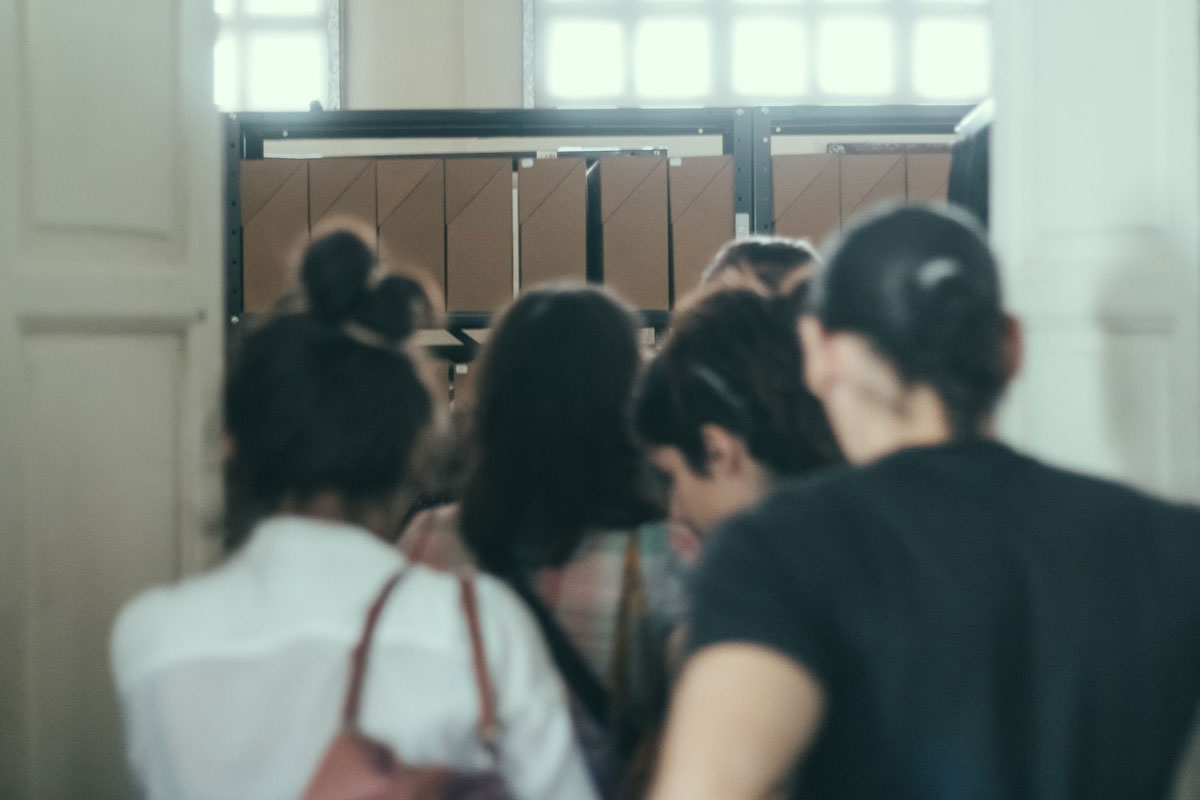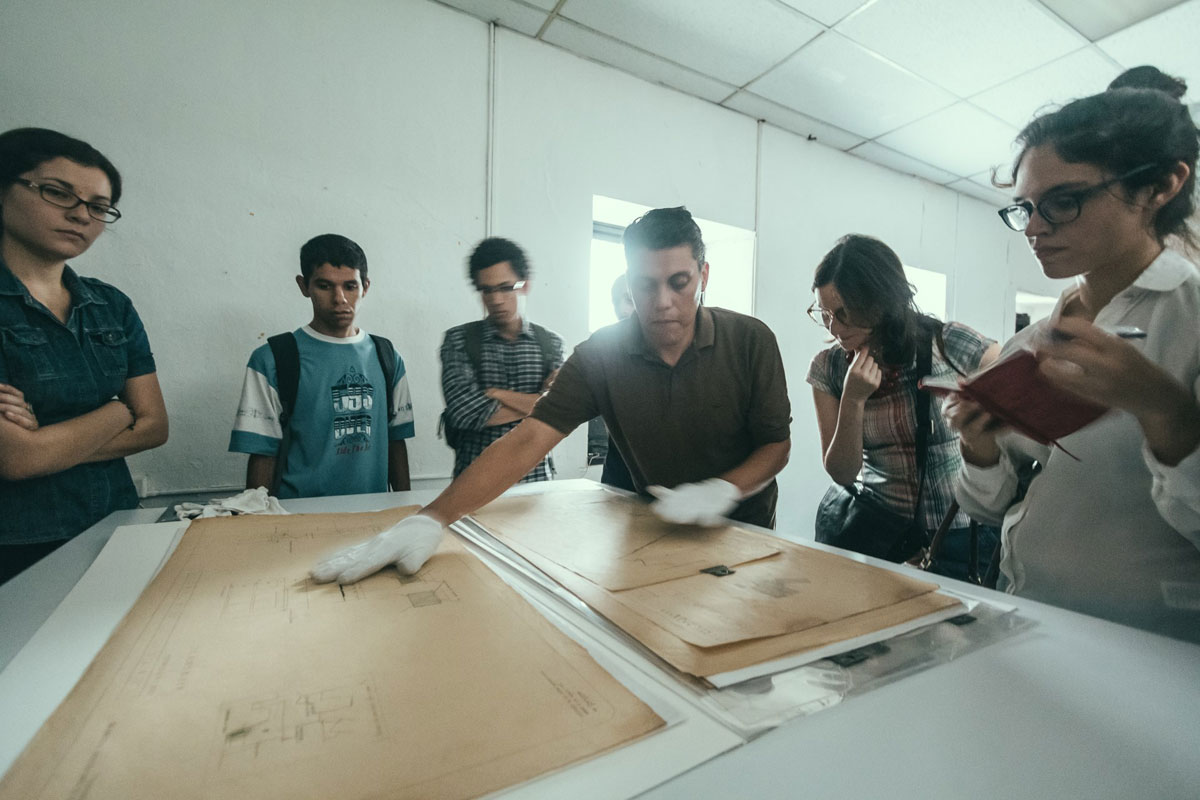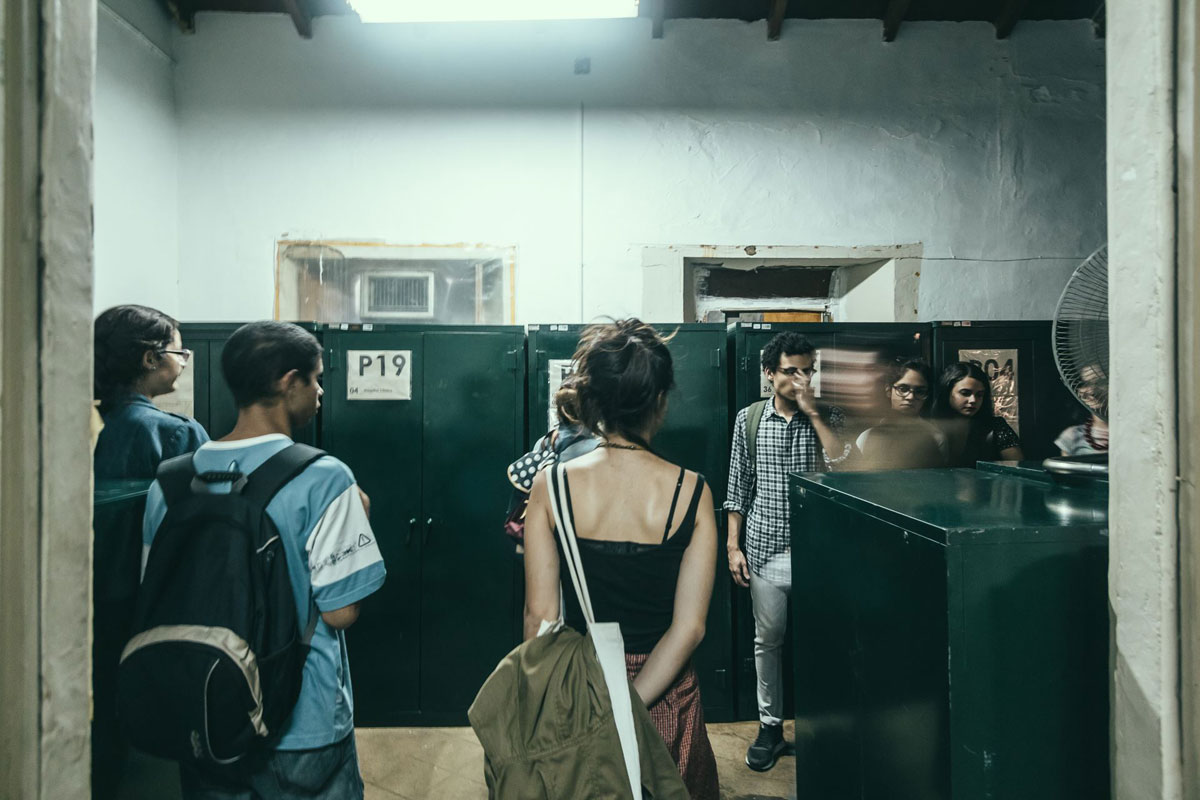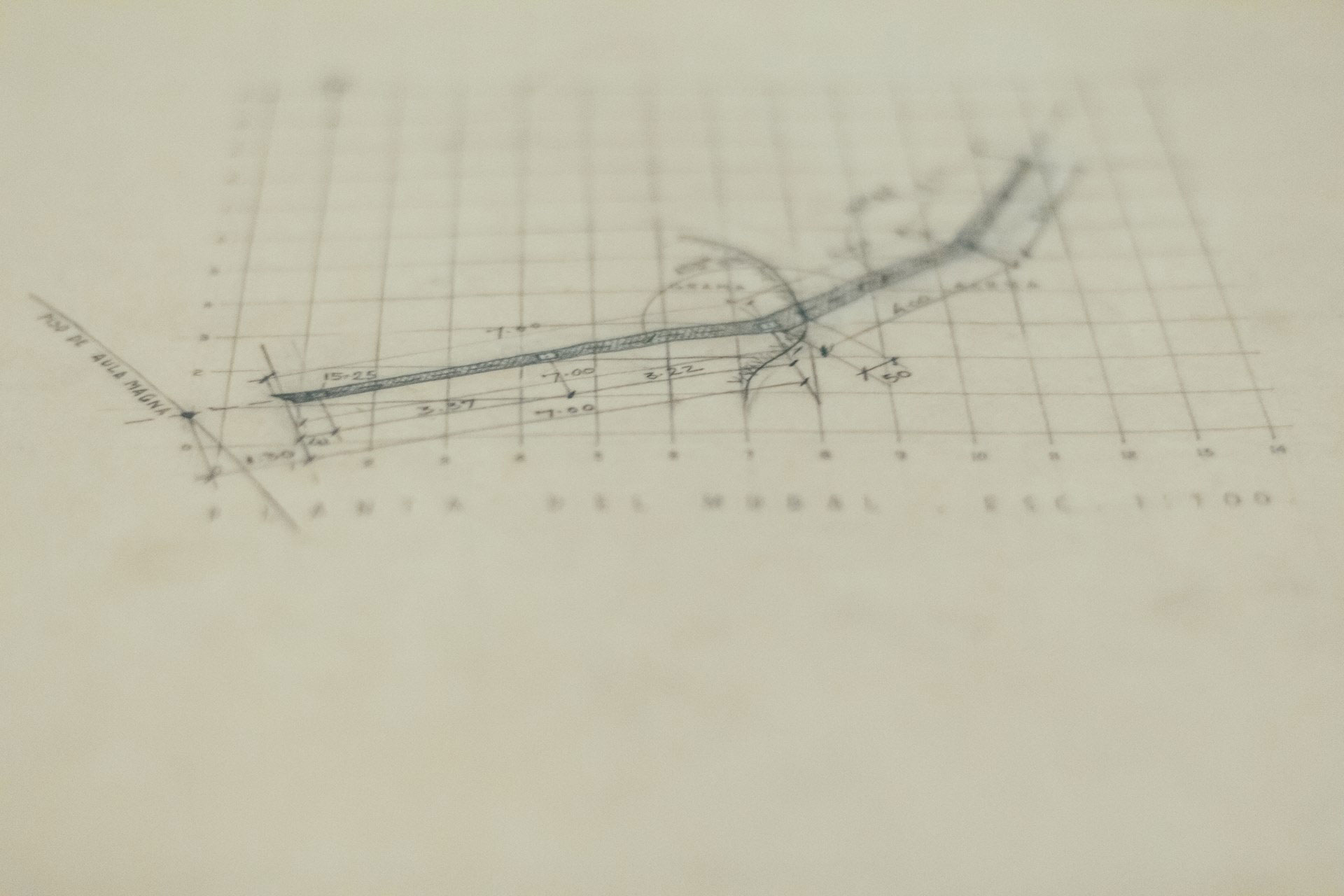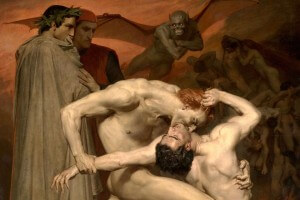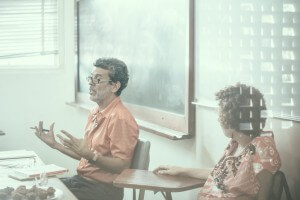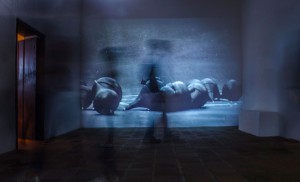In one of those elusive spots on the campus of the Universidad Central de Venezuela is the Casona Ibarra, a colonial treasure that during the 1940s served as base of operations for Carlos Raúl Villanueva. From there, he directed the construction of the University City that Unesco declared World Heritage of Humanity in the year 2000. Today, the Casona is the headquarters of the Villanueva Foundation, and it contains hundreds of plans, sketches, and documents of the illustrious architect and his project. A visit to this extensive and stimulating archive was undoubtedly inescapable in the programming of the seminar «Micropolitics of Creation, Archives, and the Cities of the Future» conducted by Camila Pulgar Machado with Backroom as guest.
The visit was guided by an intention proposed by the professor in advance: to make a sketch of the house that would contain the citizen’s point of view, a narrative and creative construct of the elements that compose the subjective experience. For this, she raised two referential notions from Armando Silva:
1) Citizen’s point of view: «I understand the citizen’s point of view to be, precisely, a series of discursive strategies through which citizens narrate the stories of their city, even though such stories can also be represented in visual images” … “I must clarify that what I understand by ‘point of view’ is a mediation operation: that which happens between the picture or image and its real observer. The point of view, therefore, involves an exercise of vision, to capture a visual record, but also to commit the gaze to the subject of emotions that is projected on and attached to what one looks at.»
2) Sketch: «… I oppose the map to the sketch. Graphically, a map can be drawn by a continuous line that indicates the visual simulacrum of the object that it is intended to represent: the map of Colombia, for example, surrounded by neighboring countries, Venezuela, Panama, Ecuador, Peru and Brazil. On the contrary, sketches are punctuated, since their destiny is to represent only evocative or metaphorical boundaries, those of a territory that does not allow precise cut-off points due to its expression of collective feeling or deep social subjectivity.»
Below, a selection of narrative scenes.
Photographs: Saúl Yuncoxar.
Sketch: La Casona Ibarra
by Valerie Weilheim
An absence melts you.
An absence picks you up.
Rafael Cadenas
On the Wednesday before the visit to the Casona Ibarra, I read about Silva’s definition of sketch, and my eagerness to draw my own grew. I thought my enthusiasm would translate into fluency in writing about the experience. Perhaps the bewilderment when I discovered that my visit would end before a closed door generated other internal closures that hampered my ability to sketch. It took me two weeks and a poetry reading about Caracas to motivate me to finally write about the experience. However, I could not stop thinking about it throughout the process: I read the sketches of my colleagues and some texts about the city, so my account of the events was traversed by fragments linked to different times, which turned it into a rather rhizomatic story that seeks to articulate a process of singularization in the form of a text.
“The story, the only possible story, is us, and the city starts and restarts on any Tuesday,” says Cabrujas in his essay The Hidden City. I did not know the Casona Ibarra, and I was excited to expand my own boundaries within the campus. That Thursday the tour began at the wrong time for me; I live in a constant hurry due to my admitted unpunctuality. Cabrujas said that “any attempt to move in Caracas is nothing more than the achievement of a goal,” and my goal that day was to reach the Villanueva archive. I met with my partner in tardiness at the cafeteria of the Communications School, and I asked him if she knew how to get there; luckily, she had gone before, and she guided me for a stretch that I found quite short. After passing past the pool (a little frequented but familiar area) my mood changed: I began to observe everything in terms of a future sketch. The first thing that signaled this change was the light between the trees: I was no longer in a constructed space, Villanueva’s games seemed to have not touched this part of the University City, as the light was filtered only by branches in a rather virgin environment. I remember saying that it would be a beautiful place to have a conversation, if it were not for the terrifying insecurity of the area.
We found the group dispersed, distributed around the Casona. We learned that something had gone wrong with the visit and that we could not enter all. I tried to comfort myself thinking that we would be back. Silva, speaking about the University City of Bogotá, proposed a type of trail he called ‘ghost road’: “When one ascends and arrives, the walker crashes into a wall where there was a doorway before.” In my imagination, where there was once an open door to Villanueva’s archive there was now a wall: the hitch of the bureaucracy to make an appointment. I approached Professor Camila; I was distracted by the front of the Casona behind her, where someone had taken the trouble to paint around the cracks to indicate that the house was being recovered. “It would be necessary to paint around the entire University City, honestly,” I thought.
In few places of the city do I allow myself to indulge in quiet contemplation of the spaces that surround me, but the University is the main one. The words of Miguel Arroyo always echo in me, and I remember them in the voice of Professor María Fernanda Palacios: «You must learn how to see.” Once, someone heard me speak about the University as “the reason to stay”, and told me that it was not healthy to be so attached. I think Cabrujas clearly states where this attachment comes from when he says that the city is, in a certain way, an eternal return to the future: “Something we perceive as an achievement, as a certainty, as the place where we will be able to recognize ourselves.” It seems to me that Villanueva had this in mind when he built the University City. The archeology proposed by Cabrujas is to find oneself in the process of digging up the city, a notion that I find very close to Silva’s views on the citizen’s point of view and to his own archive, which, as we discussed in front of the Casona, is also traversed by the things we have not yet unearthed.
The mishap with Villanueva’s archive echoed in me with Marianela Díaz Cardozo’s experience on her first approach to Airear la sala. I thought again about Cabrujas on the city: “Who knows if at the center of its enigma is its inhabitants’ impossibility to know it.” From these gaps in the archive arise concerns that motivate new machinic processes; the hidden, invisible fragments of the archive are also potency for the production of territories. I believe that impossibility made manifest a fragment previously unconscious of my own archive ––precisely, thanks to the discovery of an absence.
Log: Going Through my Memory of the University City
by Beatriz Mójer
The afternoon was still intact, and only a few clouds outlined the sky that Thursday. We left French class early, but despite our punctuality, a photocopy distracted us and we had to rush to catch up with the group. As we hurried along the corridor that connects the Faculty with the imposing building of FACES, we had a feeling of ignorance. We knew that we were headed to a site whose existence within the limits of the University City we were not aware of before. In the distance, walking awkwardly through the forest of “No Man’s Land,” we spotted the rest of the class. They walked at an anxious speed. As we moved, we burst into the rest of the day, disturbing the usually silent footsteps of those who walk the floors of Villanueva. We followed the group as if in search of something hidden.
“I’m going to get ahead so I don’t lose them!” I said eagerly to Laura and Alex as I heard their equally anxious footsteps behind me.
I remembered the last time I had walked around the pool, over a year ago. Everything felt desolate. A space is transformed not only by the passage of time, but also by the gaze that contemplates it.
A steep hill led us to the front of the Casona Ibarra in exchange for our breath. A different architecture to the usual prevailed in our eyes. The columns on the porch revealed the age of the building. The ample space to enter the house evoked an atmosphere once associated with literary gatherings. The wood of the doors and ceiling beams seemed to resist the passage of time; scaffolds to hold their fractures were on the left. I was surprised to find this relic of the UCV surrounded by absence. We seemed to be the only ones who noticed its presence on campus. The rest of the class began to walk around, to look, detail, and construct sketches of the visit. Some clustered on the front and others settled on the small island that bordered the area; the rest was spread out on the stairs of the entrance. We ruptured the silence of the Casa Grande with a knock on the wood and a tall man opened the door.
We were lucky: we were the last group to get in. The man led us into a roofless room. I was distracted by the rust on the walls, how time was slowly sweeping through the building. I was trying to imagine the house at the time it was built, and how the space we were walking in now might have looked. The man opened only one old wooden door. Inside this room, the architecture was different: two or three large tables, several stacked boxes, an office ceiling. The smell of files was characteristic. We were inside what had been Carlos Rául Villanueva’s office. The man showed us the contents of some brown folders: designs of lamps for the Hospital, yellow sheets, drawings of objects that we can now feel in reality, plans, sketches, traces of what the University is today.
I did not consider anything to be accidental. To go through memory––I think––is not simply about walking through the archives of what has been lived; it is also to recognize the blueprints, the drafts of what would become a clear memory in the life of a UCV student.
Sketch: A Visit from ‘Possible Absence’
by Jhon Sánchez
As I left the session immediately after the visit, my mind was still blank. Where could my sketch begin? I had attended the guided visit to the Casona Ibarra but had not entered, and as a result I had the feeling that I must begin reconstructing the road, not from reality but from a dream. At the beginning, my point of arrival was defined; later, that same point would end up being a mystery. Before looking at the pictures of the group that did enter, I had but a brief idea of the things they had found inside; the photographs did not arrive until a while later, like an invitation arriving at my door days after the party took place. But I am well accustomed to working from contingency, and I realized that this mishap could well be the beginning of my reflection.
What is absent, is; it operates from the realm of the possible: as the night contains the day, what we do not see is the promise of an image. In the absence of the father, Lezama conceives the seed of a future sensibility, not emptiness. What I did not see does not make me dispossessed, but a latent observer of an image that is still being defined. And since my way of rendering an image is, however, slow, I also have this: the negation of the photograph or the instant image. The stroke I need to build my sketch is not there, but rather in the words that Professor Camila directed us outside the house. I did not have the UCV on the map, but a new perspective of the University City, a mythical vision until then unknown to me: “At first, people thought that Villanueva was building a concentration camp for Pérez Jiménez.” What a powerful experience it must have been for those Venezuelans to discover, after the dictatorship, that, contrary to what they expected, the work was not intended to deprive anyone of their freedom, but rather to become a meeting place for divergent voices. It was no less than the much desired discovery of democracy.
I was not surprised to find out later in the talk that the UCV now works at 300% of its originally planned capacity, but it did wake me up from my nostalgia. The force of the present acts similarly to gravity: it always brings us back to earth. But for me, this ‘moving continuously within the contingency’ is part of the Latin American character, the cruel consequence of being forced to assimilate a millenary cultural heritage to the detriment of our own: to be born constantly, to live in perpetual adaptation. To knock on the door and discover that there is not enough room inside for all visitors, to give shape to an impression from its very absence, to understand the character of the city I live in and the time I live in, are all strokes of the first point of my sketch. For me, these are guidelines to follow and chase throughout the rest of the seminar.









